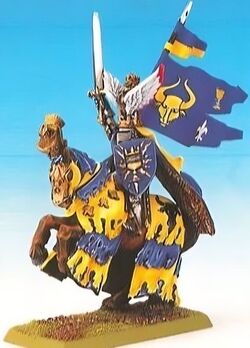
Baron Janduiá de Turín.[1a]
Baron Janduiá de Turín, also known by his symbolic title of Grand-Duc de Savoie, was a mighty Grail Knight who ruled over one of the holiest places in Carcassonne, and indeed, Bretonnia.
History[]
Baron Janduiá rules over the Grand-Duchy of Savoie, situated in the Vaults mountain range, along the River Pou, one of the tributaries of the River Brienne. It's a small land, a minor fief of the Marquis of Carcassonne, with a culture that shows a strong Tilean influence. Savoie is famous for the unbending devotion of its people and rulers to the Lady of the Lake. Its capital town, Turín, is visited all through the year by pilgrims who seek visions of the Lady in the famous chapel containing the Shroud of Gilles le Breton. This holy relic still bears the image of the hero's body, imprinted by his blood the day he was mortally wounded. In times of war, Baron Janduiá can deploy a force that is quite small, but made up of inspired and determined warriors, known collectively as Les Savoiardes, they are strong in their unquenchable faith for the Lady.[1a]
Janduiá himself is a pious Grail Knight who leads his companion knights on the battlefield under the protection of his magical banner, bearing the symbol of the bull. He adopted this Blazon after slaying, as part of his Grail Quest, the Minotaur Lord who was leading a rampaging Beastman warherd through the Dukedom of Carcassonne. Janduía is notable not just for his status, but also for his marriage. The Baron's Banner of Shielding is carried into battle by none other than Jacomettá, his wife. She was the only child of the former Grand-Duc and was an aspiring priestess until directed by a vision from the Lady onto the quest of a true knight. As such, Janduiá's wife is the only woman known to have supped from the Holy Grail.[1a]
Janduiá's first son has left to roam the lands of the Old World on his own quest for the Grail. He also has two daughters, twins, Giulia and Margherita, powerful Grail Damsels, who even studied magic in Altdorf. The twins use their powers to protect the Baron's lands and army from evil magic.[1a]
In battle, the Baron rides at the head of five other Grail Knights, known as the Wardens of the Shroud. Another mighty Grail Knight, Pierre de la Micca, is the keeper of Turín's Grail Chapel and first defender of the Holy Shroud. Serving as the Baron's greatest Champion, he rides into battle atop his noble white Pegasus, Bonarius.[1a]
Finally, another faithful knight of his is Camil Bensò, Count of the village of Cavour, who leads a regiment of his peer knights, minor lords of the fief of Savoie. They are followed into battle by their own sons, who live as Knights Errant and wear the traditional white livery that represents their humble status.[1a]
Wargear & Abilities[]
Janduiá is a Grail Knight and thus faster, stronger and more durable than any normal man. Even as a mortal Questing Knight, the Baron was capable of slaying a Doombull in single combat.[1a]
- Sword of Swift Slaying - A sword of silver that never dims. When used in anger, the sword arm of its owner darts forth before an opponent can even raise their guard.[1a]
- Tress of Isoulde - Isoulde, a damsel known for her terrifying wrath towards the foes of Bretonnia, imbued this delicate braid of hair with enchantments of vengeance and righteous anger.[1a]
- Jade Amulet - A potent magical trinket.[1a]
Trivia[]
The Grand-Duchy of Savoie is based on the real-life Duchy of Savoy, a country in Western Europe. Throughout its history, it was ruled by the House of Savoy and formed a part of the larger Savoyard state, which in 1720 became the Kingdom of Sardinia. And Turin was actually its capital.
The Shroud of Turin, also known as the Turin Shroud, is a real-life religious artifact that is believed to bear the imprinted image of Jesus Christ.
The name of Baron Janduiá and of his soldiers, Les Savoiardes, is based on a type of Italian confectionery.
